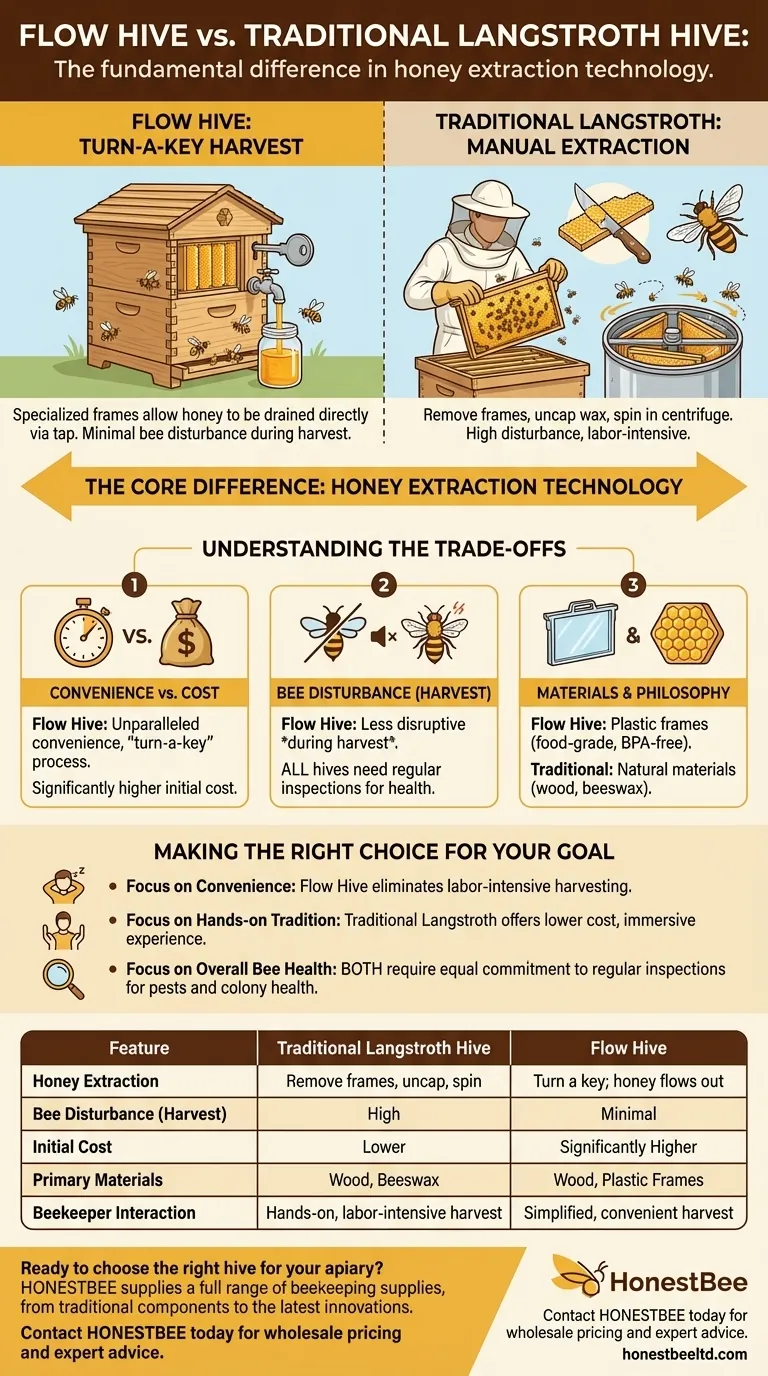The fundamental difference between a Flow Hive and a traditional hive is the technology used for honey extraction. A Flow Hive uses specialized frames that allow honey to be drained directly from the hive via a tap, eliminating the need to open the hive or disturb the bees during harvest. In contrast, a traditional Langstroth hive requires the beekeeper to physically remove the frames, uncap the wax, and use a centrifuge to spin the honey out.
The Flow Hive revolutionizes the moment of honey harvesting by prioritizing convenience and minimal bee disturbance. However, this innovation represents a significant trade-off against the lower cost, traditional materials, and hands-on process of a standard Langstroth hive.

The Core Difference: Honey Extraction
The defining feature that separates these two hive types is the design of the frames within the honey super (the boxes where bees store surplus honey). This design directly dictates how the beekeeper harvests the honey.
The Traditional Langstroth Method
A standard Langstroth hive uses simple wooden frames holding a sheet of wax or plastic foundation. The bees build their wax honeycomb on this foundation and fill the cells with honey.
Harvesting is a labor-intensive, multi-step process. The beekeeper must open the hive, remove the heavy frames, slice the wax cappings off each cell, and then place the frames in a centrifugal extractor to spin the honey out.
The Flow Hive Mechanism
A Flow Hive replaces these standard frames with patented, injection-molded plastic Flow Frames. These frames contain partially formed honeycomb cells that are complete but split vertically.
When a beekeeper inserts and turns a special key, the split cells offset, creating channels. Gravity then allows the honey to flow down and out of the hive through a spout, directly into a jar, without ever opening the hive or removing a frame.
Understanding the Trade-offs
Choosing between these systems is not just about technology; it's about weighing convenience against cost, tradition, and the nature of your interaction with the bees.
Convenience vs. Cost
The Flow Hive offers unparalleled convenience during the harvest. The "turn-a-key" process is clean, simple, and can be done in minutes with very little equipment.
This convenience, however, comes at a significantly higher initial cost compared to a traditional Langstroth hive setup.
The Nature of Bee Disturbance
The Flow Hive is specifically designed to be less disruptive during the honey harvest. The bees are left relatively undisturbed as their honey is drained away.
However, it's a critical misconception that Flow Hives require no hive inspections. All beekeepers must still open their hives regularly to check on the queen, monitor for pests like varroa mites, and ensure the overall health of the colony's brood.
Materials and Philosophy
Traditional hives primarily use natural materials like wood and beeswax. Many beekeepers prefer this, believing it's a more natural environment for the bees.
The Flow Hive's core technology relies on plastic frames. While made from food-grade, BPA-free plastic, this is a philosophical dividing line for some beekeepers who prefer to keep plastic out of the hive.
Making the Right Choice for Your Goal
The right hive depends entirely on what you want to achieve as a beekeeper.
- If your primary focus is convenience and a simplified harvest: The Flow Hive's on-tap system is specifically designed to eliminate the most labor-intensive part of beekeeping.
- If your primary focus is a traditional, hands-on experience at a lower initial cost: A standard Langstroth hive is the time-tested industry standard that immerses you in every step of the process.
- If your primary focus is overall bee health: Recognize that both hive types require equal commitment to regular, hands-on hive inspections to manage pests and ensure a thriving colony.
Ultimately, the best hive is the one that aligns with your goals and encourages you to be an attentive, responsible steward of your bees.
Summary Table:
| Feature | Traditional Langstroth Hive | Flow Hive |
|---|---|---|
| Honey Extraction | Remove frames, uncap, spin in extractor | Turn a key; honey flows out via tap |
| Bee Disturbance (Harvest) | High | Minimal |
| Initial Cost | Lower | Significantly Higher |
| Primary Materials | Wood, Beeswax | Wood, Plastic Frames |
| Beekeeper Interaction | Hands-on, labor-intensive harvest | Simplified, convenient harvest |
Ready to choose the right hive for your apiary?
Whether you manage a commercial operation or supply equipment to distributors, selecting the correct hive is critical for efficiency and bee health. HONESTBEE supplies a full range of beekeeping supplies and equipment, from traditional Langstroth components to the latest innovations, through our wholesale-focused operations.
Let our expertise guide you to the optimal setup for your specific goals. Contact HONESTBEE today for wholesale pricing and expert advice to ensure your beekeeping success.
Visual Guide

Related Products
- Professional Hive Top Bee Feeder for Beekeeping
- HONESTBEE Professional Long Handled Hive Tool with Precision Cutting Blade
- Commercial 48-Frame Stainless Steel Honey Extractor
- HONESTBEE 3-Frame Manual Acrylic Honey Extractor
- electric honey extractor honey centrifuge 3 frame honey extractor stainless steel honey frame extractor
People Also Ask
- What are the features of top feeders for bees? Maximize Hive Health with Safe, High-Capacity Feeding
- Do I need an inner cover with a hive top feeder? Optimize Your Hive Setup for Healthy Bees
- What is the best bee feeder for a hive? Choose the Right Feeder for Your Apiary's Scale
- What is a top feeder for bees? Maximize Colony Health with Efficient Feeding
- What are the advantages of hive top feeders? Maximize Feeding Efficiency for Your Apiary



















